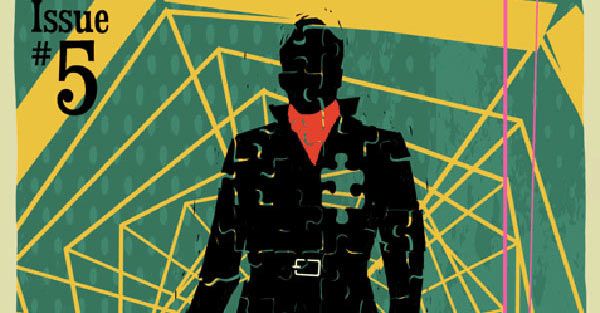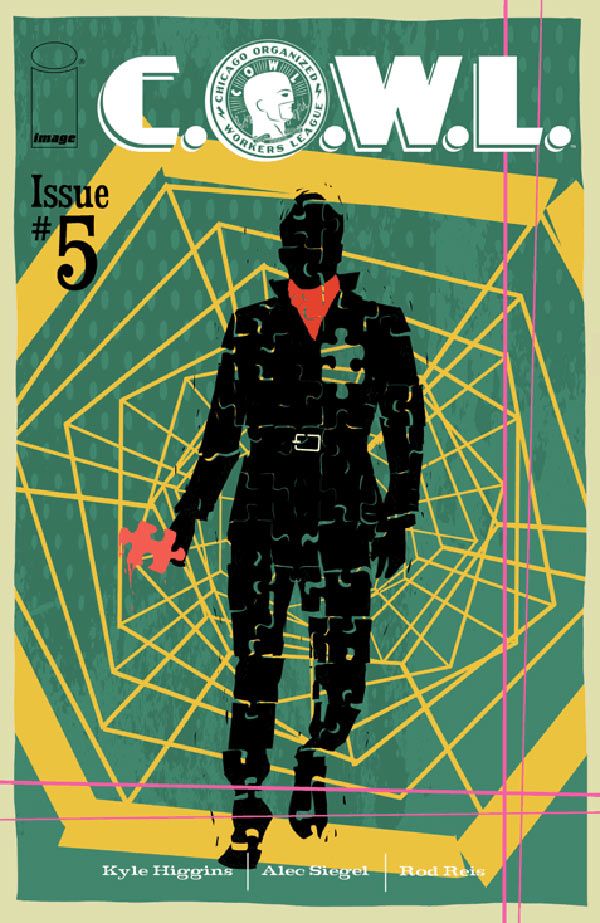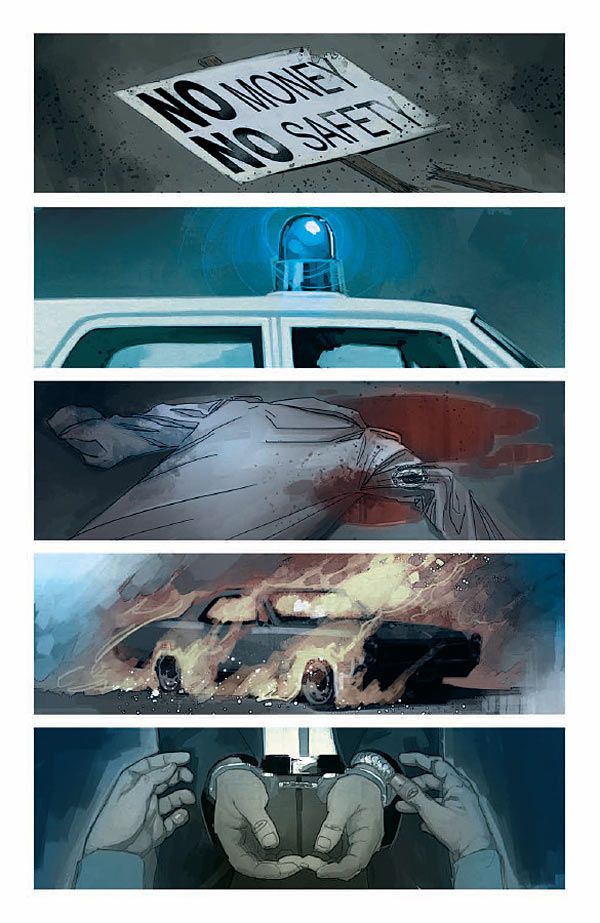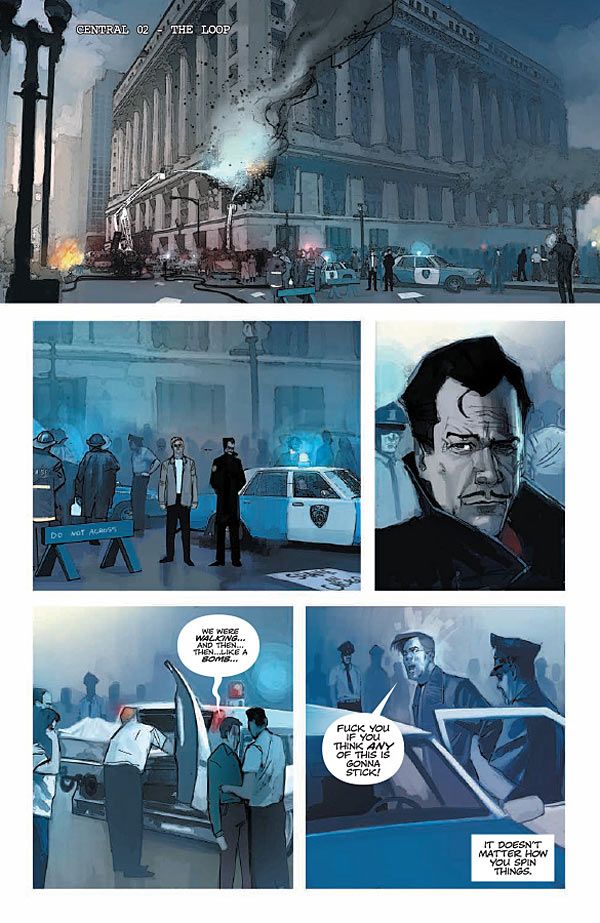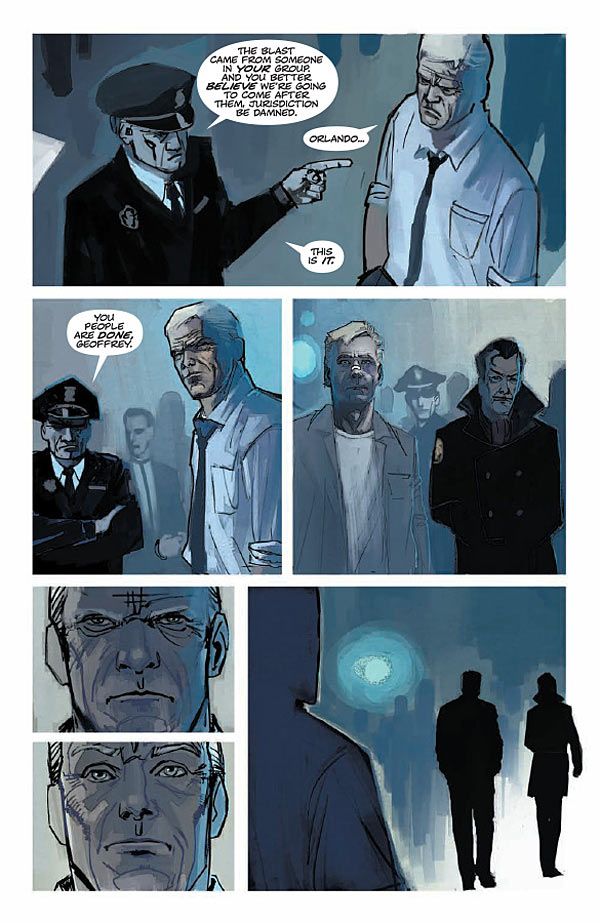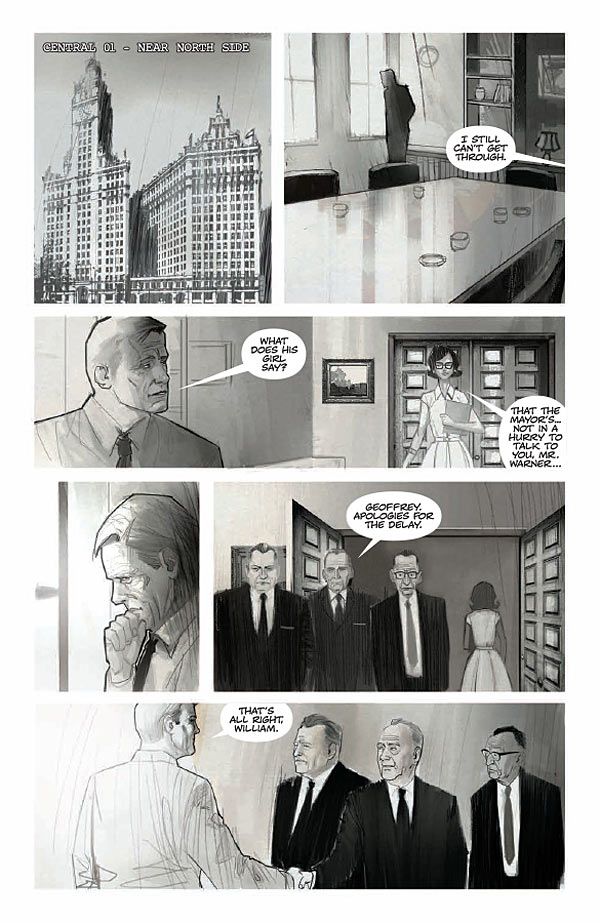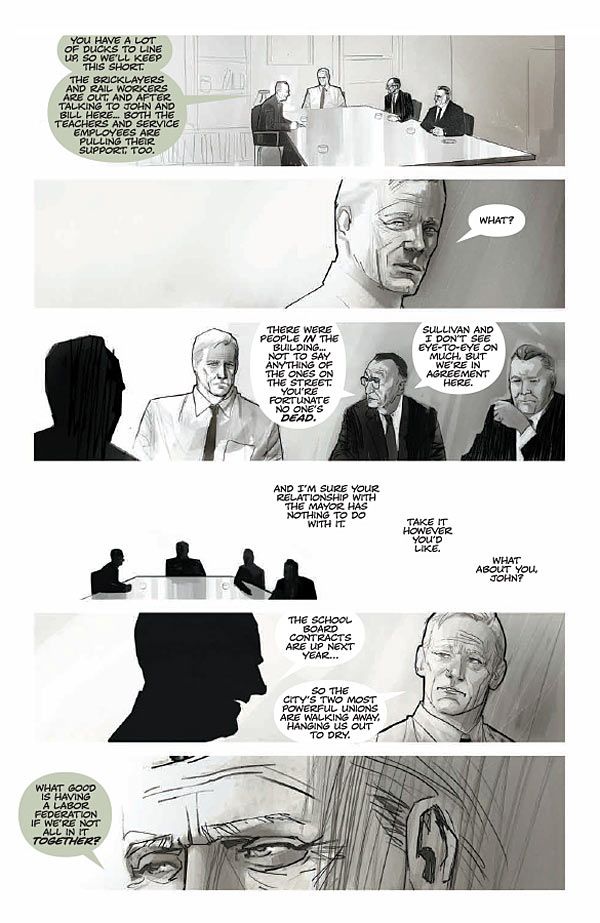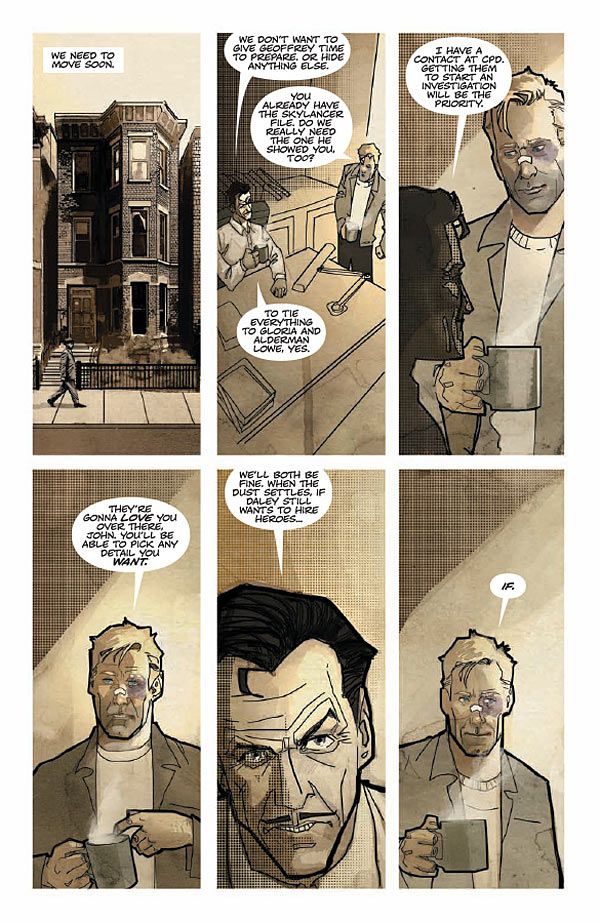[SPOILER WARNING: Spoilers ahead for this week's "C.O.W.L." #5
Writer Kyle Higgins' Image Comics series "C.O.W.L." may spin the story of a superhero union in the 1960s, but as of this week's new issue, the title organization is having a much harder time keeping things together.
With issue #5 out this week, Higgins, co-writer Alec Siegel and artist Rod Reis dealt a one-two punch of twists for the series. While the Chicago Organized Workers League had been pushing to renew its contract with the city from the start of the book, things were about to fall apart thanks to an impending scandal in the office of C.O.W.L. founder Geoffrey Warner (once known as the superhero The Grey Raven). After Warner covered up how leaked C.O.W.L. designs led to a super crime spree, would-be whistleblower John Pierce was all ready to take his boss's dirty laundry to the papers. That is, he was until his former friend Arclight killed John, labeling him a Scab to the picketing superheroes. Meanwhile, Warner set a deal in place with mob boss Camden to bring waves of supervillains back to the city in order to strengthen the union's bargaining position.
The moves certainly complicate the series, but as Higgins explained to CBR News, the move to dirty the hands of the unionized protectors is one long in the making. As "C.O.W.L." ramps up for it second arc (a trade for the first arrives at the end of October), more secrets are set to come out, idealistic characters are set to be broken and an unexpected version of supervillainy is ready to take the stage.
CBR News: Kyle, the latest issue of "C.O.W.L." had a couple of big twists all centering around the lengths union founder Geoffrey Warner was willing to go to in order to keep the organization around. But one of the things that stood out to me while reading the issue is that despite the monstrous things he does to get his way, Warner doesn't feel like a mustache-twirling villain. What's your view on him and his tactics at this point in the book?
Kyle Higgins: That's kind of the whole point and is a big reason we set the series in the era we did. It's very much a shades of grey world. It's that Cold War paranoia. Your neighbor could be an enemy. That was the lens we were interested in looking at superheroes through. As far as that relates to Geoffrey Warner and his role in the first arc, we wanted to see what it would be like when you took a man like that and backed him into a corner. C.O.W.L. could be at its last days, so what kind of decisions would he have to make to perpetuate this organization? There are big costs to this both for Geoffrey and Chicago. In some ways, it's the beginning of a false flag operation [with the reintroduction of supervillains]. But for him personally, it's his last attempt to stay relevant and stick around. He's always been an "ends justify the means" guy, but this is a whole new level of that.
Who do you consider the main character of this book? Several cast members who looked like they'd fill a traditional crusading hero role have either been twisted around or even killed. Do you have one person that you follow a little more closely?
It really is an ensemble book. Geoffrey is probably the closest we have to a main character -- especially after John's death. But there are some new characters we're going to be introducing, and they're going to not be members of C.O.W.L. One of the most important ones is a female detective named Evelyn who is the one investigating John's murder from the police side. She does have a relationship with C.O.W.L. In fact, she used to be a member. So there's bad blood there.
But the thing we're interested in doing starting with the second arc is expanding the world a little bit more, if you can believe that. In the first arc, all the point of view characters were members of C.O.W.L. We wanted to keep it focused on the internal mechanisms of the group, but from here on out we want to also include some faces from outside of C.O.W.L. and how they relate to the organization -- how different people in the city view Geoffrey and the heroes.
Beyond that, the big characters coming up include Radia who still has a big role, as do Blaze and Eclipse. Those three plus Geoffrey provide our main point of view in this second arc. And Grant Marlow will come back. He hasn't been seen since the end of issue #2 when he was shot. But that event really drove Karl and Kathryn to go on their crusade against [mob boss] Camden and his super powered enforcers. So Grant will start some research into things, and his story is one of my favorites. That event from the end of #2 has big consequences for him and his relationship with C.O.W.L.
Looking at a few of the characters you mention, Kathryn -- AKA Radia -- has had a very complicated set of relationships with many men in the book who all attempt to define her or control her. This relationship with Karl where they're going out and taking on the mob anonymously seems a response to that. What do you think she wants overall?
I think Kathryn wants to matter, but she wants to matter as a person. That might sound cliched, but she doesn't particularly like the way the world works to put her in a box. I think that idea is still relevant in this day and age. And her relationships with the different men in C.O.W.L. is mostly about them trying to control her, though I don't think they always see that they're doing that. But the relationship she has with Karl is different in our minds. He sees her for what she is -- arguably the most powerful member of C.O.W.L. The friendship there is a lot of fun to write because it really is a genuine friendship that's forming. And her awakening towards the end of the first arc and into the second arc is the beginnings of her pushing back -- looking to define herself for herself. It's a little early in the timeline to tackle the Women's Liberation movement in the book, but in our minds, she's a precursor to that.
On the other side of things, we have Blaze. On the face, he seems like a good soldier for C.O.W.L. but we know he has history with the founders of the organization, so it feels like there's a lot more story to tell there. Is that something that picks up in the second arc?
We're going to be exploring his back story in a big way going forward. If you read issue #4 carefully, you realize that he's actually with his brother's wife and son. His brother was the Dart -- Chicago's arguably greatest villain. So there's a big history there and a big story that informs a lot of Geoffrey and Reginald's relationship now. If there's one constant in this book, it's that secrets don't stay hidden. So that's definitely stuff that will be coming to light soon here.
The big cliffhanger turn at the end of #5 is that the villains are returning at Geoffrey's secret request. Aside from the obvious moral dimensions this holds for C.O.W.L. as a union, is this also just an opportunity for you guys to go buck wild creating early '60s mafia supervillains?
Yeah, that is a lot of fun actually. We're getting into that right now in some of the design work. Issue #6 is a one-shot origin of the Grey Raven done as a 1960s comic books. Then issue #7 is the next big arc, and the opening to that is kind of the introduction to the first villain in the book. It's not what you expect at all. The idea from the end of #5 of the villains coming back is not quite as easy as you think it would be.
Much in the way that we explored the inner workings of C.O.W.L. and its relationship with the city, we'll be exploring the world of the villains in the same detail. It's cool getting into the mechanics of it and how it might work -- how the villains start and who will be up for doing it while they try to keep a secret. But the other cool thing about the ending of #5 is that the turn that Arclight makes on John -- killing him in order to keep the conspiracy a secret -- is something that is going to permeate the second arc in a big way. That conspiracy that came from the fact Skylancer's weapons were designed by C.O.W.L. and leaked out via Geoffrey's secretary and Alderman Lowe and Geoffrey's choice to bury that in order to avoid a scandal and sign a new contract? That's only the beginning. It has nothing to do with creating the villains, but it's a precursor to that in some ways.
And whether Arclight was acting on Geoffrey's authority is something we'll have to see in the next couple of issues. But unfortunately, John really is dead. Sometimes the good ones don't make it out alive.
What's the response been for the book overall, and how are you feeling moving on to creator-owned work? Has the experience been what you expected?
It has been, definitely. It's been a lot of work, but that's not a negative thing, really. It's different muscles than I've been stretching at DC. Controlling your own world is incredible exciting, but it's also very O.C.D. inducing. I have a background in graphic design, and so I'm pretty involved in even the very minute details of the design of this book. I'm getting all the files together and loaded to the Image FTP so we can go to the printer. It's work that for me is quite rewarding. Being able to shape something along with Alec and Rod and Trevor [McCarthy on covers] is fantastic.
And I'd say that the reception has been pretty overwhelming, to be honest. We weren't sure what to expect with something like this -- a political crime-centric superhero book in the '60s? But we're doing it because we're passionate about it. The fact that people have been willing to give it a shot as much as they have been is very rewarding.
"C.O.W.L." #5 is on sale now from Image Comics.

